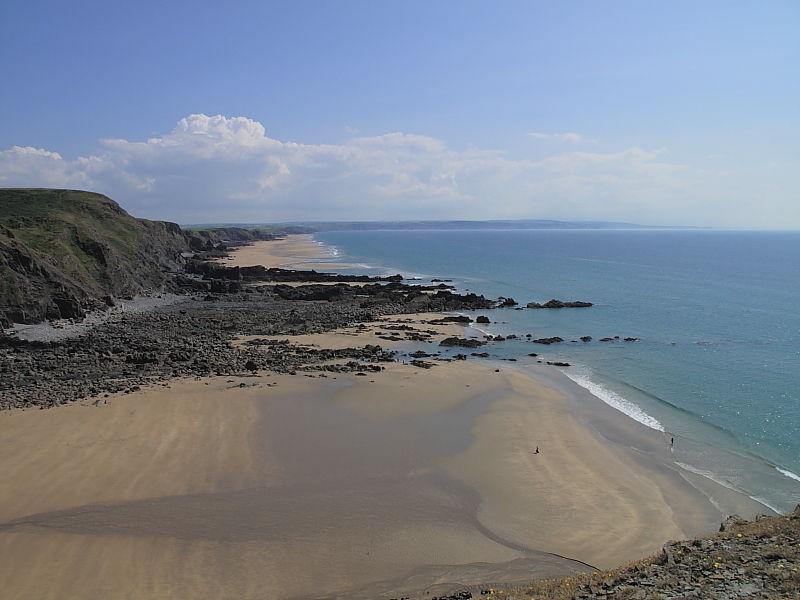 |  | | Nearest sites: Morwenstow | Sandymouth |
| Spotlight species | | Common Blue Butterfly: this is the only blue butterfly likely to be seen on the south-facing slope and can sometimes be seen in large numbers between spring and autumn visiting flowers and laying eggs on Common Bird’s-foot-trefoil.
Fulmar: several pairs of this common sea bird nest on the rugged cliffs. At any time of the year it is possible to have exceptional close up views of them flying around the cliff face below Steeple Point.
Burnet Moths: three life-cycle stages of this dramatically coloured day-flying moth can be found between early spring and late autumn. In the summer hundreds may be seen flying over the south-facing slopes, visiting flowers and mating on stems.
Fox Moth: in late summer and autumn the large hairy caterpillars of this moth can often be seen sunbathing on the steep path leading up to Steeple Point or feeding on various plants. The female moth flies at night but occasionally the male may be seen during the day as it searches for a female to mate with. | | Wild Flowers | | | The steep south-facing slope leading up to Steeple Point is a blaze of colour in late May when Common Bird’s-foot-trefoil, Kidney Vetch, Sea Campion and Thrift are in full bloom. Ling and Bell Heathers add a late summer splash of colour. | | Birds | | | Raven, Stonechat, Rock Pipit, Kestrel, Peregrine, Fulmar, Linnet, Jackdaw and gulls can be seen all year around the cliffs. Oystercatcher, Shag and Cormorant can often be seen on the rocks. During the spring migration Wheatear pass through in numbers with some staying to breed. Grey Wagtail can often be seen along the stream. | | Butterflies | | | The most common species to be found on the steep south facing slopes in late spring and summer are Common Blue, Meadow Brown and Small Heath. Gatekeeper, Wall Brown, Small Copper, Large Skipper, Small Tortoiseshell, Peacock, Large White, Green-veined White and Ringlet occur in small numbers. Migratory butterflies such as Red Admiral, Painted Lady and Clouded Yellow are recorded annually but their numbers are extremely variable from year to year. | | Day-flying moths | | | Hundreds of the colourful Five- and Six-spot Burnet moths can often be seen flying in sunshine up and down the steep, grassy south-facing slopes during the summer. Burnet Moth caterpillars and their silky cocoons attached to the tops of grass stems are easy to see in the spring and summer. The common miratory moth Silver Y can often be seen sipping nectar from Ling and Bell Heather. Yellow Belle may be see in small numbers. During good weather and southerly air streams you may be lucky and see the migratory Hummingbird Hawk-moth hovering around a rocky outcrop or taking nectar from flowers. | | Caterpillars | | | Watch your step in late summer as large, hairy Fox Moth caterpillars are common along the steep path leading up to Steeple Point. Burnet Moth caterpillars can also been seen often in the spring feasting on plants such as Common Bird’s-foot-trefoil. Caterpillars of moths The Drinker, Ruby Tiger, Cream-spot Tiger and Emperor Moth may also be seen. More caterpillars can be seen in hairy caterpillars and the British caterpillar gallery | | Insects | | | | There is an amazing diversity of insects at Duckpool from the very common Soldier Beetle, often seen in pairs on the flower heads of Sea Carrot, to the numerous grasshoppers, shieldbugs and beetles. | | Site information | | - Location: Duckpool is situated 4 miles north of Bude on the Atlantic coast of North Cornwall. The area is managed by the National Trust.
- GPS: 50.87569,-4.560528
- Parking: small, free car park
- Facilities: toilets, occasional ice-cream van
- Walking: The path north is steep with sheer drops to the sea. The view from Steeple Point goes all the way to Trevose. Going south from Duckpool, the path is again steep but this time it climbs a grassy slope without sheer drops. Sandymouth is only 1.5miles away but in between is Warren Gutter, another steep fall and ascent.
| | Beach information | | - Type: pebble beach with sand at low tide
- Dogs: allowed
- Lifeguards: none
|
| Advertise on this page?Click here to email Wildlife Insight. |